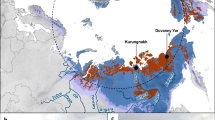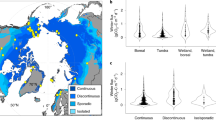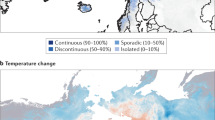Abstract
Permafrost thaw liberates frozen organic carbon, which is decomposed into carbon dioxide (CO2) and methane (CH4). The release of these greenhouse gases (GHGs) forms a positive feedback to atmospheric CO2 and CH4 concentrations and accelerates climate change1,2. Current studies report a minor importance of CH4 production in water-saturated (anoxic) permafrost soils3,4,5,6 and a stronger permafrost carbon–climate feedback from drained (oxic) soils1,7. Here we show through seven-year laboratory incubations that equal amounts of CO2 and CH4 are formed in thawing permafrost under anoxic conditions after stable CH4-producing microbial communities have established. Less permafrost carbon was mineralized under anoxic conditions but more CO2–carbon equivalents (CO2–Ce) were formed than under oxic conditions when the higher global warming potential (GWP) of CH4 is taken into account8. A model of organic carbon decomposition, calibrated with the observed decomposition data, predicts a higher loss of permafrost carbon under oxic conditions (113 ± 58 g CO2–C kgC−1 (kgC, kilograms of carbon)) by 2100, but a twice as high production of CO2–Ce (241 ± 138 g CO2–Ce kgC−1) under anoxic conditions. These findings challenge the view of a stronger permafrost carbon-climate feedback from drained soils1,7 and emphasize the importance of CH4 production in thawing permafrost on climate-relevant timescales.
This is a preview of subscription content, access via your institution
Access options
Access Nature and 54 other Nature Portfolio journals
Get Nature+, our best-value online-access subscription
$29.99 / 30 days
cancel any time
Subscribe to this journal
Receive 12 print issues and online access
$209.00 per year
only $17.42 per issue
Buy this article
- Purchase on Springer Link
- Instant access to full article PDF
Prices may be subject to local taxes which are calculated during checkout



Similar content being viewed by others
References
Schuur, E. A. G. et al. Climate change and the permafrost carbon feedback. Nature 520, 171–179 (2015).
McGuire, A. D., Chapin, F. S. III, Walsh, J. E. & Wirth, C. Integrated regional changes in arctic climate feedbacks: implications for the global climate system. Annu. Rev. Environ. Resour. 31, 61–91 (2006).
Lee, H., Schuur, E. A. G., Inglett, K. S., Lavoie, M. & Chanton, J. P. The rate of permafrost carbon release under aerobic and anaerobic conditions and its potential effects on climate. Glob. Change Biol. 18, 515–527 (2012).
Treat, C. C. et al. Temperature and peat type control CO2 and CH4 production in Alaskan permafrost peats. Glob. Change Biol. 20, 2674–2686 (2014).
Waldrop, M. P. et al. Molecular investigations into a globally important carbon pool: permafrost-protected carbon in Alaskan soils. Glob. Change Biol. 16, 2543–2554 (2010).
Roy Chowdhury, T. et al. Stoichiometry and temperature sensitivity of methanogenesis and CO2 production from saturated polygonal tundra in Barrow, Alaska. Glob. Change Biol. 21, 722–737 (2015).
Schädel, C. et al. Potential carbon emissions dominated by carbon dioxide from thawed permafrost soils. Nat. Clim. Change 6, 950–953 (2016).
Myhre, et al. in Climate Change 2013: The Physical Science Basis (eds Stocker, T. F. et al.) 659–740 (Cambridge Univ. Press, Cambridge, UK, 2013).
Hugelius, G. et al. Estimated stocks of circumpolar permafrost carbon with quantified uncertainty ranges and identified data gaps. Biogeosciences 11, 6573–6593 (2014).
Jorgenson, M. T. et al. Reorganization of vegetation, hydrology and soil carbon after permafrost degradation across heterogeneous boreal landscapes. Environ. Res. Lett. 8, 035017 (2013).
Bring, A. et al. Arctic terrestrial hydrology: a synthesis of processes, regional effects, and research challenges. J. Geophys. Res. Biogeosci. 121, 621–649 (2016).
Treat, C. C. et al. A pan-Arctic synthesis of CH4 and CO2 production from anoxic soil incubations. Glob. Change Biol. 21, 2787–2803 (2015).
Natali, S. M. et al. Permafrost thaw and soil moisture driving CO2 and CH4 release from upland tundra. J. Geophys. Res. Biogeosci. 120, 525–537 (2015).
Johnston, C. E. et al. Effect of permafrost thaw on CO2 and CH4 exchange in a western Alaska peatland chronosequence. Environ. Res. Lett. 9, 085004 (2014).
Knoblauch, C., Beer, C., Sosnin, A., Wagner, D. & Pfeiffer, E.-M. Predicting long-term carbon mineralization and trace gas production from thawing permafrost of Northeast Siberia. Glob. Change Biol. 19, 1160–1172 (2013).
Liebner, S. et al. Shifts in methanogenic community composition and methane fluxes along the degradation of discontinuous permafrost. Front. Microbiol. 6, 356 (2015).
Angel, R., Claus, P. & Conrad, R. Methanogenic archaea are globally ubiquitous in aerated soils and become active under wet anoxic conditions. ISME J. 6, 847–862 (2012).
Ping, C. L., Jastrow, J. D., Jorgenson, M. T., Michaelson, G. J. & Shur, Y. L. Permafrost soils and carbon cycling. SOIL 1, 147–171 (2015).
Voigt, C. et al. Warming of subarctic tundra increases emissions of all three important greenhouse gases—carbon dioxide, methane, and nitrous oxide. Glob. Change Biol. 23, 3121–3138 (2017).
Symons, G. E. & Buswell, A. M. The methane fermentation of carbohydrates. J. Am. Chem. Soc. 55, 2028–2036 (1933).
Nilsson, M. & Öquist, M. in Carbon Cycling in Northern Peatlands (eds Baird, A. J., Belyea, L. R., Comas, X., Reeve, A. S. & Slater, L. D.) 131–144 (Geophysical Monograph Series Vol. 184, American Geophysical Union, Washington, DC, USA 2009).
Hodgkins, S. B. et al. Changes in peat chemistry associated with permafrost thaw increase greenhouse gas production. Proc. Natl Acad. Sci. USA 111, 5819–5824 (2014).
Knoblauch, C., Spott, O., Evgrafova, S., Kutzbach, L. & Pfeiffer, E.-M. Regulation of methane production, oxidation and emission by vascular plants and bryophytes in ponds of the northeast Siberian polygonal tundra. J. Geophys. Res. Biogeosci. 120, 2525–2541 (2015).
Cooper, M. D. A. et al. Limited contribution of permafrost carbon to methane release from thawing peatlands. Nat. Clim. Change 7, 507–511 (2017).
Schädel, C. et al. Circumpolar assessment of permafrost C quality and its vulnerability over time using long-term incubation data. Glob. Change Biol. 20, 641–652 (2014).
Elberling, B. et al. Long-term CO2 production following permafrost thaw. Nat. Clim. Change 3, 890–894 (2013).
Walter Anthony, K. et al. Methane emissions proportional to permafrost carbon thawed in Arctic lakes since the 1950s. Nat. Geosci. 9, 679–682 (2016).
Popp, T. J., Chanton, J. P., Whiting, G. J. & Grant, N. Evaluation of methane oxidation in the rhizosphere of a Carex dominated fen in north central Alberta, Canada. Biogeochemistry 51, 259–281 (2000).
Friborg, T., Soegaard, H., Christensen, T. R., Lloyd, C. R. & Panikov, N. S. Siberian wetlands: where a sink is a source. Geophys. Res. Lett. 30, 2129–2132 (2003).
Wille, C., Kutzbach, L., Sachs, T., Wagner, D. & Pfeiffer, E.-M. Methane emission from Siberian arctic polygonal tundra: eddy covariance measurements and modeling. Glob. Change Biol. 14, 1395–1408 (2008).
Boike, J. et al. Baseline characteristics of climate, permafrost and land cover from a new permafrost observatory in the Lena River Delta, Siberia (1998–2011). Biogeosciences 10, 2105–2128 (2013).
Kutzbach, L., Wagner, D. & Pfeiffer, E.-M. Effect of microrelief and vegetation on methane emission from wet polygonal tundra, Lena Delta, Northern Siberia. Biogeochemistry 69, 341–362 (2004).
Morgenstern, A. et al. Evolution of thermokarst in East Siberian ice-rich permafrost: a case study. Geomorphology 201, 363–379 (2013).
Yamamoto, S., Alcauskas, J. B. & Crozier, T. E. Solubility of methane in distilled water and seawater. J. Chem. Eng. Data 21, 78–80 (1976).
Millero, F., Huang, F., Graham, T. & Pierrot, D. The dissociation of carbonic acid in NaCl solutions as a function of concentration and temperature. Geochim. Cosmochim. Acta 71, 46–55 (2007).
Amundson, R. & Baisden, W. T. in Methods in Ecosystem Science (eds Sala, O. E., Jackson, R. B., Mooney, H. A. & Howarth, R. B.) 117–137 (Springer, New York, USA, 2000).
Andrén, O. & Kätterer, T. ICBM: the introductory carbon balance model for exploration of soil carbon balances. Ecol. Appl. 7, 1226–1236 (1997).
Meentemeyer, V. Macroclimate and lignin control of litter decomposition rates. Ecology 59, 465–472 (1978).
Steinberg, L. M. & Regan, J. M. mcrA-targeted real-time quantitative PCR method to examine methanogen communities. Appl. Environ. Microbiol. 75, 4435–4442 (2009).
Acknowledgements
We acknowledge the financial support through the Cluster of Excellence 'CliSAP' (EXC177), Universität Hamburg, funded through the German Research Foundation, the CarboPerm project funded by the German Ministry for Research and Education (03G0836A) to C.K., C.B. and E.-M.P. and the Helmholtz Gemeinschaft by funding the Helmholtz Young Investigators Group of S.L. (VH-NG-919). We also thank G. Hugelius for valuable discussions, D. Wagner and S. Zubrzycki for providing samples, B. Schwinge for laboratory assistance, W. Schneider and G. Stoof for help during the field campaigns and the German and Russian colleagues from the Alfred Wegener Institute in Potsdam, the Lena Delta Reserve in Tiksi and the Tiksi Hydrobase for logistical support.
Author information
Authors and Affiliations
Contributions
C.K. and C.B. designed the study. C.K., E.-M.P and M.N.G. did the field work. C.K. conducted the incubation experiment, C.B. calibrated the model and predicted site-level and pan-Arctic GHG production and S.L. quantified the methanogen abundance. C.K. and C.B wrote the manuscript with contributions from all the co-authors.
Corresponding author
Ethics declarations
Competing interests
The authors declare no competing interests.
Additional information
Publisher’s note: Springer Nature remains neutral with regard to jurisdictional claims in published maps and institutional affiliations.
Supplementary information
Supplementary Information
Supplementary Results, Supplementary Figures 1–2, Supplementary Tables 1–6 and Supplementary References
Rights and permissions
About this article
Cite this article
Knoblauch, C., Beer, C., Liebner, S. et al. Methane production as key to the greenhouse gas budget of thawing permafrost. Nature Clim Change 8, 309–312 (2018). https://doi.org/10.1038/s41558-018-0095-z
Received:
Accepted:
Published:
Issue Date:
DOI: https://doi.org/10.1038/s41558-018-0095-z
This article is cited by
-
Relative increases in CH4 and CO2 emissions from wetlands under global warming dependent on soil carbon substrates
Nature Geoscience (2024)
-
The Society of Information and the European Citizens’ Perception of Climate Change: Natural or Anthropological Causes
Environmental Management (2024)
-
Sensitivity of Arctic CH4 emissions to landscape wetness diminished by atmospheric feedbacks
Nature Climate Change (2023)
-
Responses of seven wetlands carbon sources and sinks to permafrost degradation in Northeast China
Journal of Soils and Sediments (2023)
-
Dissolved organic matter from surface and pore waters of a discontinuous permafrost watershed in central Alaska reveals both compositional and seasonal heterogeneity
Aquatic Sciences (2023)



